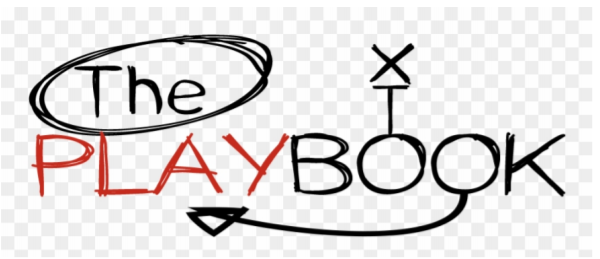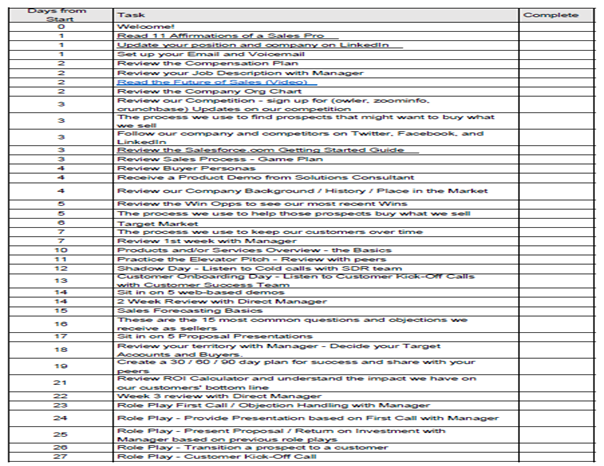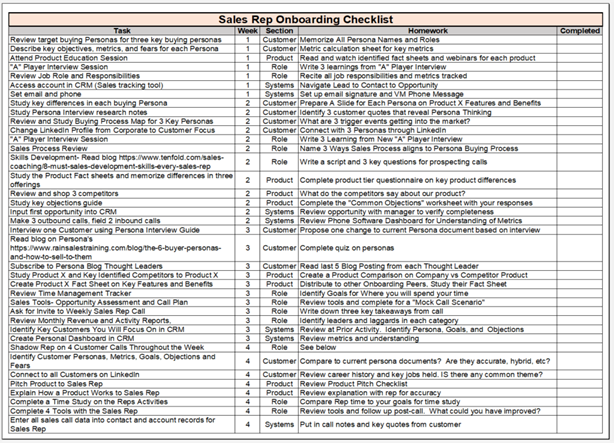Definition:
A sales operations playbook is effectively a description of all the things that are engaged in running a sales organization and the contents of which Sales Operations will create and/or own. Remember “Sales operations is a set of business activities and processes that help a sales organization run effectively, efficiently and in support of business strategies and objectives.”
Your first and most important starting points are the Vision and Mission Statement for Sales Operations. If you need a framework look at my About page. Now you need to group your primary responsibilities (these often change based on your companies’ size and maturity)
In this post, I will pose questions that ask you to look at the contents of your playbook and you can decide what is important to document in your playbook.
Objective
To supply a rough guide to the organization, structure, and content of a sales operation’s playbook. Your playbook is the primary document that will provide an overview or blueprint for your company.
Your Sales Operations playbook should include the following:
Sales Planning:
Sales planning is an ongoing process, not a one-time annual occurrence. You may call this Territory Planning, which would include a TAM Analysis, a white space evaluation, and a greenfield review. No matter how you may describe this, it is important to note that all effective planning involves collecting, collating, and analyzing operational data all year long, then delivering insights and intelligence to sales leaders and managers that enable better decision making.
Your playbook should include the following:
Target Market Definition
- Industries/GEO/Segments (e.g. enterprise / mid-market)
Territory Definitions
- Description of rules used to define territories
Org Chart
- Sales org chart along with dotted line resource relationships
Current Territory Assignments
- Territory designation (e.g. Retail, Manufacturing, IOT, Enterprise, Northeast) and Name of Rep assigned
- Show who is assigned/aligned with the territory (e.g. SDR, Presales engineering…)
If you do not dedicate sufficient time and resources to developing your sales plan, then you will fail. As I wrote in the previous post, Sales Operations must understand what the best practices are needed to ensure that sales, marketing, and product teams collaborate to optimize the sales planning process.
Your Marketing team can invest heavily in the planning and analysis that are essential to sales, but lack of, or just poor communication and collaboration with all key stakeholders, keep this analysis from being considered and included in the sales plan.
On-Boarding
Do you have a well-thought-out hiring profile that clearly outlines the kind of seller who can succeed in your organization? Do you have a comprehensive onboarding program that quickly ramps up new hires to full productivity? What are the Objectives & Timeline, e.g. week 1, month 1, month 6, 1 year, what are the specific skill set to be learned e.g. week 1, month 1, month 6, 1 year? What are the methods to demonstrate they have learned the skills? What is your certification program (if applicable)? What does a Cohort Reporting/Dashboards for new Reps look like, 6 months, 12 months 18 months?
Below are two examples that can be customized (click the link to see the google sheet) to help you onboard a new Sale Rep:
Quota & Compensation aka Incentive Management
As discussed in detail in my post on Sales Compensation your playbook should include:
Compensation Plan Structure
- By type, if more than one type
Manager, Rep, Overlay, alliance, presales, etc.
- Examples of Compensation Plans (by type if multiple types)
- Sales Rep
- Sales Manager
- SDR Rep
- SDR Manager
- Lead Dev Rep
- Pre-Sales Engineer
Quotas by Rep Type and Territory
- Rep
- Manager (with factor)
- Corporate Quota (with Factor)
Spiff Structure
- Example: Basic types to be used
Sales Reporting, Analysis, and Intelligence
Data governance
Do you have the processes and technologies required to supply actionable information from sales intelligence data?
Before you establish your SOP, review the Data Governance white paper from Salesforce. Then you can begin to define and detail the “Responsible” (who owns the data), the “Accountable” (sign-off or approve changes) “Consulted” (provides information and support), and the “Informed” (notified only). Your playbook should detail the process and technologies that your CRM users will follow.
Reporting
- Do you use predictive analytics to predict buyers’ behavior, or do you only take a historical view?
- What is your BI tool (excel, MS Power BI, InsightSquared, Tableau, Klipfolio…).
Depending on the stage of the pipeline and with the requirement of your CRO/VP Sales, there are four main kinds of analytics – descriptive, diagnostic, predictive, and prescriptive. Descriptive Analytics tells you what happened in the past. Diagnostic Analytics helps you understand why something happened in the past. Predictive Analytics predicts what is most likely to happen in the future. Prescriptive Analytics recommends actions you can take to affect those outcomes.
In your playbook you need to, define your reporting goal. Understand your data source (see Data Governance). Prepare your data reporting, then analyze the data, then report on results. (dashboards, detailed reports, etc.) Your reporting should also be tailored to your various stakeholders, (Individual Rep report vs. the C-Suite roll-up report).
Your playbook also provides the standard operating procedures for sales and should include:
Lead Qualification Process
- Call Methodology
- Lead Scoring
Pipeline Review Process
- Meeting Cadence, Attendees, Agenda
- Pipeline Reports/Dashboards
Sales Process
- Sales Stages, objective evidence (MEDDIC)
- Opportunities, Quotes, Proposal, SOW Templates
- Escalation Process(es); Discounting, Legal Terms, Commercial Terms etc.
Pipeline Review Process
- Meeting Cadence, Attendees, Agenda
- Example: Pipeline Reports/Dashboards
Big Deal Tracking Process
- How do you inspect and support big deals (e.g. top 10 in a Q)
- Big Deal Reports/Dashboards
Territory Arbitration Process
- Arbitration Rules
- Decision Timeframe
Deal Desk
- Role of deal desk and process to engage
Forecasting Process
- What is Meeting Cadence, Attendees, Agenda
- What is your reporting aggregation process (what does a rollup forecast report look like for your CRO)?
Manager Meetings Template
- Meeting Cadence, Attendees, Agenda
- Reports/Dashboards
Quarterly/Annual Operations Review Template (QBR)
- Meeting Cadence, Attendees, Agenda
- Reports/Dashboards
Quarterly/Annual Sales Performance Measurement Template
- Performance by manager/segment/ region
- Against plan, against forecast
- QOQ/YOY/YTD compare
Read on to part II where I will discuss more content for your playbook



Leave a Reply